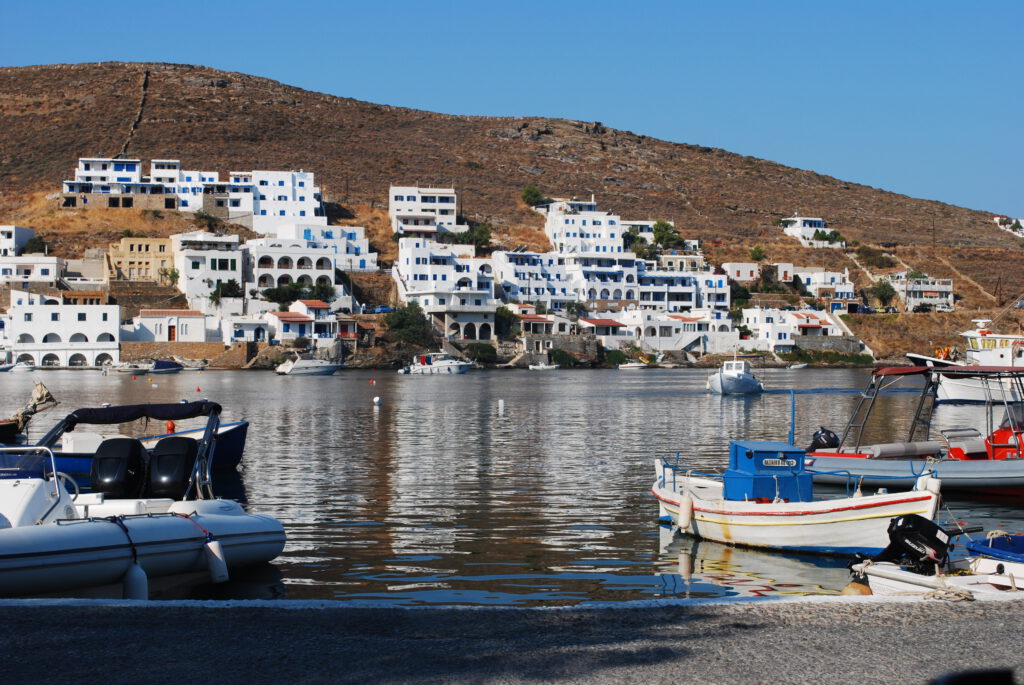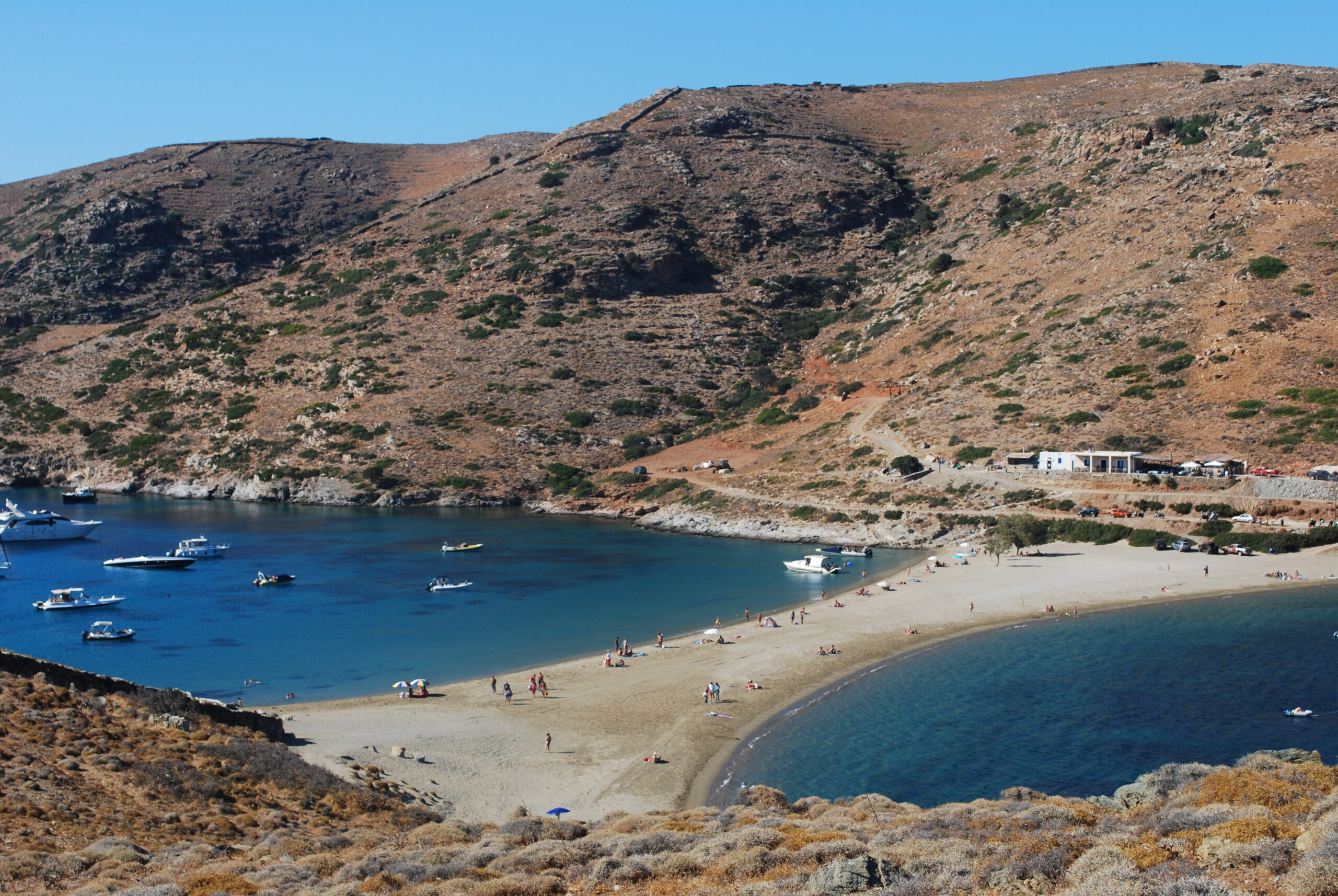Kithnos (size 100 km², 1500 inhabitants, also Kythnos) is not very touristy. The few visitors come from the nearby mainland. The island is hardly prepared for foreign guests. The English and German menus that are otherwise common in Greece are nowhere to be found in most taverns on Kithnos. Agriculture is still the main source of income on the poor island. Prices are pleasantly low. Since Athenians come to Kithnos mainly on summer weekends, you should avoid this time.
Our opinion: Kithnos offers a wonderful mix of untouched nature and traditional villages that create an authentic atmosphere. However, the island has its own, rather quiet rhythm, which could seem a little too tranquil for travelers looking for a lot of variety. Nevertheless, Kythnos remains a place of relaxation that captivates with its relaxed aura.
 By Roman Klementschitz – Own work, CC BY-SA 3.0, Link
By Roman Klementschitz – Own work, CC BY-SA 3.0, Link
Accommodation in Kithnos: Almost all accommodation on the island can be booked online via Booking.com: Click here. We can recommend Foinikas Studios almost directly on the harbor, good value for money.
Merichas: The ferry port town of Kithnos does not have much to offer tourists, but it has a quiet and pleasant atmosphere. No good beaches and no real Cycladic atmosphere (many newer houses). There are a few smaller pensions and room rentals around the harbor (average prices, rooms from 30 euros).
Chora: Beautiful main town of Kithnos. Typical Cycladic town in the mountains. Chora still seems unspoiled. Very conservative and old-fashioned – if you are looking for a place in the Cyclades like it was 10-20 years ago, the Chora of Kithnos is not wrong. Also ideal for those seeking peace and quiet.
Driopis: A traditional, larger village on Kithnos with a small museum that is worth seeing
Loutra: The most famous village on Kithnos. Loutra is known for its hot springs, the water of which was said to have healing properties even in ancient times. A higher-class hotel about 100 years old, but which has probably seen better days. It is right next to the springs and is called the Xenia Hotel (double room about 50 euros, Tel.: +30 22810 31217). There are also some cheaper accommodations (room rentals). Loutra is by the sea, with a few small beaches in the area. In summer, many Athenians come here.
Kanala: Small town in the south of Kithnos with a pilgrimage church for Greek Orthodox believers and a good sandy beach. The big church festival, which takes place every year on August 15th, is interesting. However, it is particularly difficult to find accommodation on Kithnos then due to the large number of Greek visitors.
Dryopida: A charming village with traditional houses and the remarkable Katafyki cave system to explore.
Buses on Kithnos: A bus leaves the port about 5 times a day up to Chora and other villages described above. The bus is usually ready when the ferry arrives.
Ferries to Kithnos: Daily connections to Athens, Serifos and Milos. Rare connections to the neighboring island Kea. Unfortunately, there is no direct connection to the main Cyclades. There is no airport on the island in the Cyclades.
Beaches Kithnos:
Kolona Beach: One of the most famous beaches on the island. It consists of a narrow sandbank that separates two sides of the sea – a spectacular sight!
 By Roman Klementschitz – Own work, CC BY-SA 3.0, Link
By Roman Klementschitz – Own work, CC BY-SA 3.0, Link
Apokrousi Beach: A long, quiet beach with shady trees, ideal for families.
Episkopi Beach: An easily accessible beach with tavernas nearby.
Kythnos has been using solar and wind energy for several years. Now the majority of the electricity on the island comes from green electricity.
Hiking Kithnos
Kythnos is a paradise for hikers who want to discover untouched nature, traditional villages and breathtaking coastal landscapes. The island has a well-signposted network of hiking trails that connect historical and scenic highlights. Here are some of the best hikes and tips:
Popular hiking routes
Chora – Loutra – Agia Irini
Length: approx. 6 km
Duration: 2-3 hours
Highlights:
Start in Chora, the picturesque main town on the island.
Hike inland to the famous hot springs of Loutra.
The trail continues to the small church of Agia Irini with fantastic sea views.
Dryopida – Katafyki Cave – Lefkes
Length: approx. 5 km
Duration: 2 hours
Highlights:
Start in the traditional village of Dryopida, known for its beautiful tiled roofs.
Visit the Katafyki Cave, one of the largest caves in Greece.
Continue through olive groves and past dry stone walls to the quiet beach of Lefkes.
Kolona – Apokrousi – Vryokastro
Length: approx. 7 km
Duration: 3-4 hours
Highlights:
The starting point is the famous Kolona beach.
From there, the trail leads along the coast to the equally quiet Apokrousi beach.
The end point is the archaeological site of Vryokastro, the ancient capital of the island, with panoramic views of the Aegean Sea.
Agios Stefanos – Agios Ioannis
Length: approx. 8 km
Duration: 4 hours
Highlights:
A more challenging route that starts at the secluded bay of Agios Stefanos.
The trail leads over hills and past small chapels to the church of Agios Ioannis.
Enjoy the absolute silence and untouched nature along the way.
Why hike on Kythnos?
1.Traditional trails: Many hiking trails follow centuries-old paths that were once used by locals.
2.Diversity: From gentle coastal trails to more challenging mountain trails, the island offers something for every hiker.
3.Pure nature: Especially in spring, the island blooms in full splendor, with wild flowers and aromatic herbs.
Kithnos Animals (Fauna)
While Kythnos is not an island with spectacular wildlife, it does have an interesting mix of native flora and fauna that is particularly appealing to nature lovers and hikers. Here are some of the animals you can spot on the island:
Land Animals
1.Goats and Sheep
Kythnos is known for its small farms, and goats and sheep can be found grazing freely all over the island. They are part of the traditional way of life of the islanders.
2.Cats
As in many Greek regions, street cats are ubiquitous on Kythnos. They are an integral part of village life and are often very friendly.
3.Lizards and Geckos
Several species of small lizards and geckos can be seen on the island, often sunbathing on the rocks and walls of the traditional villages during the warmer months.
4.Hares and hedgehogs
In rural areas of the island there are wild hares and occasionally hedgehogs, which are particularly active in the evenings.
Kythnos is a great place for bird watching, especially in spring and autumn when migratory birds pass through the island.
1.Seagulls and terns
These seabirds are commonly seen on the coasts and beaches.
2.Birds of prey
Eagles and buzzards can occasionally be seen in the mountainous regions.
3.Songbirds
Blackbirds, sparrows and other small songbirds make the island lively.
Sea creatures
Kythnos offers clear waters that are home to a variety of sea creatures.
1.Fish and crustaceans
Snorkelers and divers can see a variety of fish such as bream, parrotfish and mullet.
Crustaceans such as crabs and lobsters are also found in the waters.
2.Octopus and squid
They are common in the bays and are an important part of the local cuisine.
3.Sea turtles
If you are lucky, you may see one of the sea turtles that are found in the Aegean Sea.
4.Dolphins
Sometimes dolphins accompany ferries or small boats, especially in the morning hours.
Link: Prices for gondola rides Venice
Kithnos Map
|
Kythnos lies between the island of Kea in the north, the island Siros in the east and the island Serifos in the south. The tiny island of Piperi east of Kythnos is uninhabited. Piperi Island is a refuge for seals (monk seal). |
Do you have feedback, an addition, found an error or a comment? Send us an email to: mail@griechenland-insel.de